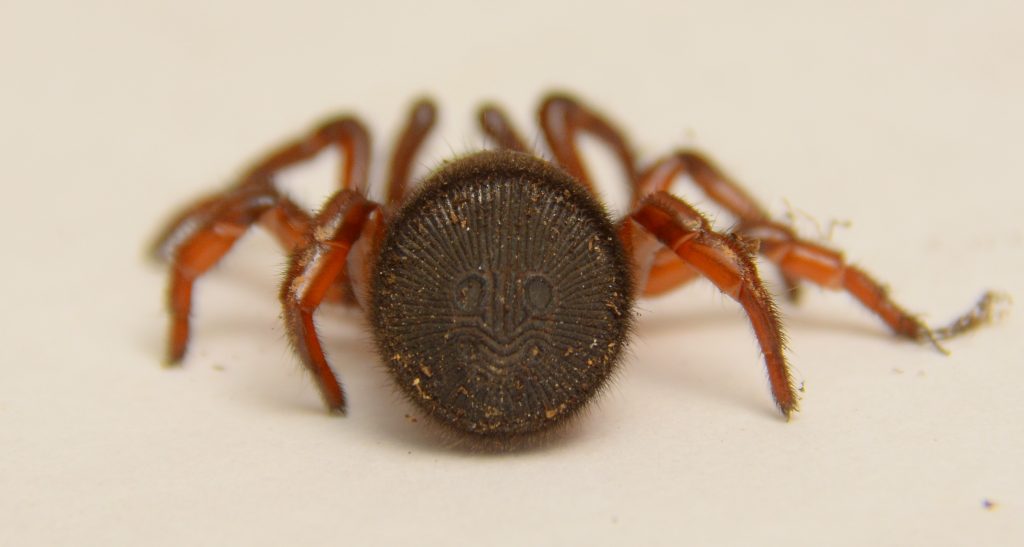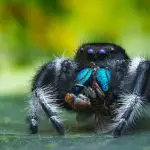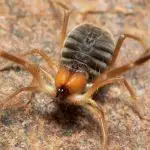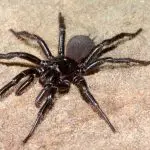Last updated on February 1st, 2023 at 09:59 am
The Ravine Trapdoor Spider is weird species that has the unusual adaptation of a hard, flattened rear-end for blocking its burrow to predators…
Ravine trapdoor spiders belong to trapdoor spider family, Ctenizidae. In this spider genus, the abdomen terminates in a tough disc that is reinforced by a network of ribs and grooves.
When attacked, they use this to block the entrance to their deep vertical burrows. This process is known as phragmosis.
Ravine trapdoor spider location
The unusual, oddly formed spiders Cyclocosmia truncata, which are a member of the Ctenizidae family of trapdoor spiders, are known as the ravine trapdoor spiders. The Ctenizidae live around the world, but favor warm climates.
The sloping ravines and riverbanks of North America, including Alabama, Georgia, and Tennessee are home to the ravine trapdoor spider that most of us here in the USA are familiar with.
Ravine trapdoor spider venom
Humans are not at high danger from the trapdoor spider’s non-toxic bite. It is a cautious, non-aggressive spider, but if it feels threatened, it may rise up and show its fangs.
Although trapdoor spiders seldom bite, when they do, it can hurt a lot. You may experience local pain and swelling.
Ravine trapdoor spider facts
Physical appearance of the spiders
This large spider with thick legs has the appearance that its abdomen, or back half, has been severed. The spider appears as a sturdy, flat, round shield from behind that resembles a manhole cover.
Six round dents may be found in the shield’s center. Dents in the surface are connected by grooves to a bristled rim.
The shield’s color is black, and the body is dark brown. The spider has eight eyes, four above and four below, grouped closely in two rows.
Ravine trapdoor spider habitat
Here are some interesting facts about the ravine trapdoors habitat:
- A trapdoor spider lacks a web and dig down a borrow in soil. On top of a burrow, there is a trapdoor.
- Burrows made by trapdoor spiders are around 5 centimeters wide and 30 centimeters deep.
- They occasionally like to dig their burrows close to rivers or creeks so they may capture little fish.
- Ravine trapdoor spiders prefer moist, shady slopes, and construct their tunnels in soil that is sandy.
- The vertical tube-shaped burrow has a bottom that gradually becomes smaller.
- The spider builds a hinged entrance out of a silk wafer at a burrow’s top and drapes the walls with silk. With the help of the trash, it conceals the door’s outside.
How do the spiders protect themselves and hunt?
To attack passing bugs, the spider hides behind its trapdoor and waits. When a wasp or other parasite manages to get in, the spider quickly dives to the burrow’s base, leaving the predator with nothing but its sturdy armor.
The shield attaches to the burrow’s walls so firmly that it makes it nearly hard to remove the spider. In this situation, the spider’s tactic is sit and wait: sooner or later the predator gets frustrated and moves on.
Reproduction and lifecycle
The majority of a ravine trapdoor spider’s life is spent underground. Males emerge from their burrows and look for mating when they reach adulthood.
The mating takes place in the female’s burrow. Shortly after mating, the male passes away.
A few months after mating, the female trapdoor spider will lay her eggs, which she will defend in her burrow. In the burrow, the female lays eggs within a sac. After hatching, the spiderlings stay for several months before leaving. Then they will dig their own little tunnels.
When a spider becomes bigger, it has to expand its burrow. Annual concentric rings—rings with a shared center, like circles or spheres—can be found in intact trapdoors.
The average lifespan of a female is 12 years. The males die after mating at a younger age, however.
Ravine trapdoor spider enemies
Wasps, scorpions, and humans are some of a trapdoor spider’s adversaries. A wasp will rush inside the spider’s burrow as soon as it discovers it and sting the spider.
The spider must use its teeth to grip the door in order to save itself. The wasp often prevails because its razor-sharp fangs cut through the burrow’s lid.
Wasps typically deposit one egg per spider after stinging it, placing their eggs on the spider’s body. Birds, centipedes, opossums, raccoons, scorpions, flies, and parasitic wasps are some other predators of ravine trapdoor spiders.
How long do trapdoor spiders live?
Trapdoors have a lengthy lifespan of five to 20 years and develop over a number of years. Males leave their burrows after they are adult and travel in quest of a mate, whilst females remain in or close to their burrows.
Males generally live much shorter lives than females. This is partly because they die after mating, but also because they are more exposed to predators when looking for mates.
Ravine trapdoor spider bite
Though they avoid humans at all costs, a very irritaded trapdoor spider will bite. The pain from their bites might continue for a few days even though they are not highly venomous.
Overall, the bites of trapdoor spiders are mild, but vary according to each person’s individual reaction. Any bug bite can cause an allergic reaction, and should be monitored closely.
Ravine trapdoor spider size
The female ravine trapdoor spiders are 1.2 inches(30 mm) long. They are larger than the males. The length of a male trapdoor is 0.75 inches (19 mm).
What you will notice with this species and trapdoor spiders in general is that they have short legs. Though they are technically small in size, they are actually much stockier and heavier than other spiders with a similar legspan.
Can you have a trapdoor spider as a pet?
Although trapdoor spiders are frequently maintained as exotic pets, they are extremely fragile and should only be kept by knowledgeable persons. They also tend to spend most of their time hiding, which makes a lot of enthusiasts choose to keep tarantulas instead.
Nonetheless, trust me when I tell you that watching trapdoor spiders snap up their food never gets old! You might only see your spider once a week, but it’s worth it.
Ravine trapdoor spider for sale
Ravine trapdoor spiders are available for purchase online at incredibly reasonable costs. These interesting spiders build trapdoor-equipped tunnels that they utilize to ambush unaware victims.
When placing an order, you can specify whether you would like a male or female spider (or any mix thereof). A knowledgeable arachnid expert can make an effort to choose the precise spider(s) you are seeking.
How to take care of your ravine trapdoor spider?
Here are some steps to take care of your pet spider:
- Feeding: Trapdoor spiders happily eat crickets. An ideal size for insects is one-third the size of your spider. You can feed once or twice a week, although young spiders will require more frequent feedings as they develop. If your spider is not in need of food, remove live insects from its container.
- Providing water: As enough water is often collected from the spider’s diet, maintaining a wet substrate will prevent your spider from becoming dehydrated. If the spider needs water, it will come out of the tunnel to sip from water droplets and wet substrate near the burrow opening.
- Arranging proper enclosure: The container must have sufficient depth for the spider to burrow. Small plastic terrariums and screw top tubs both make excellent enclosures. The minimum substrate depth for young spiders should be 5 cm, and as the spider grows, this depth can be gradually increased. Adult spiders need a substrate that is at least 10 cm deep. The best substrate is coco-peat, which should be maintained moist but not overly soggy. Despite the fact that these spiders cannot scale flat surfaces, a sturdy lid is nevertheless advised.
- Maintaining temperature: This species can endure temperatures as high as 25°C and as low as the low 20s. Avoid being exposed to temperatures above 30°C, which can lead to heat discomfort and even death.
- Checking everything: When molting or during periods of colder weather, these spiders may go for several weeks without eating. It might be challenging to check on them without disturbing their burrow because they are tunnel dwellers. By opening the lid and leaving it ajar, you can quickly see if everything is still well. If everything is okay, the spider should eventually approach and shut it. Using a flashlight, you might be able to see the spider by looking down the tunnel. If you’re doing this to keep them from digging a hole, remove all live food from the enclosure.
How long does a trapdoor spider live?
A typical trapdoor spider may live for five to 20 years. But they can live more than that in special cases. Personally, I think that a trapdoor spider should live for at least 8 to 10 years if you get its care right. Really, 12 – 15 years would be a reasonable expectation.
A female wild trapdoor spider, commonly known as #16, resided near Tammin in Australia. She was the longest-living spider ever found. She passed away in 2016 at an age of 43.
Do spiders live longer in captivity?
The longevity of a spider can vary. The average lifespan of a spider is two years, although some spiders can live as long as 20 years when kept in captivity.
Male spiders often live shorter lives. Within two to six years, most male spiders (even tarantulas) achieve adulthood and die after mating.
That said, if you have a female trapdoor spider, she will almost certainly live longer in captivity than the wild. In captivity, she won’t have to deal with predators, parasites, droughts or disease.
FAQ relating to the Ravine Trapdoor Spider
Is the ravine trapdoor spider poisonous?
Yes, it is. Well, technically speaking it’s actually venomous, as it has a mechanism for injecting its poison. When a ravine trapdoor spider captures its victim, it does use venom, but it usually targets insects and other small-bodied arthropods. If it bites you, the area can become red and swollen, and the pain may continue for a few days.
How poisonous is a trap door spider?
Although a trapdoor spider bite is rarely harmful, it can be uncomfortable and result in some localized swelling. As a general rule, trapdoor spiders tend to have mild but painful.
Notwithstanding, there are many species of Trapdoor Spider that we know very little about. My advice is to always be cautious around any species that you can’t identify with absolute certainty.
Can you handle a trapdoor spider?
Trapdoor spiders are not dangerous but they can be aggressive. You need to be an expert to handle them or keep them as pets.
Most of them are strangely placid when out of their burrows, and either play dead or freeze when you touch them. Others, though will rear up and display their fangs as a threat. Very occasionally, still others will bite suddenly.
Where do most trapdoor spiders live?
Trapdoor spiders are a typical garden inhabitant in Tasmania and throughout eastern and southern Australia. You can also find them in Japan, North and South America, Africa, southern and eastern Asia and the Mediterranean basin.
They frequently appear when shifting rocks or digging up soil. Even while some don’t really create hinged doors, they all dig burrows.







